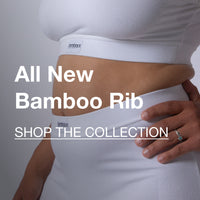What's the Best Material Used for Underwear?

Is every pair of underwear the same? There are so many characteristics that set each pair apart from the next. From all the styles and cuts to the colors and designs, it’s safe to say that most kinds of underwear are notably different in one way or another.
If you have been wearing the same brand of underwear for years, it might be time to try something new. Or, perhaps you’ll discover in this article that you’ve been living your best underwear life already! So, how do you choose your next pair?
One of the main reasons you could be in love with one brand over the next is the materials. Looking into the fabrics used to make your favorite pairs of underwear can help you find a new pair that you’re guaranteed to love.
Which Underwear Material Is Best?
Now, let’s dive into the nitty gritty of each material.
Here are (almost) all the materials that are most commonly used to make underwear and the pros and cons of each one.
Cotton
Cotton is one of the most popular materials used when making underwear. It is easy to produce, widely available, and inexpensive. Cotton is in so many products that we use and wear every day, and underwear is no exception.
Cotton is ideal for underwear because of how breathable and absorbent it is. This quality can reduce the risks of yeast infections and other troublesome conditions. Cotton is particularly helpful when sewn in as the crotch lining on a pair of underwear.
Despite being a lightweight, breathable material for underwear, cotton also has some downsides. One of the main cons to this material is that it’s often unethical to produce.
Organic Cotton: The Essentials
Cotton is one of the most chemically intensive crops — unless you produce it organically.
Shopping sustainably from brands that rely on organic cotton farming helps fund the organic farming industry. Plus, when you support brands that care about their materials, you’ll receive a higher-quality product.
Cotton is incredible when it’s used the right way. Look for an OEKO-Tex certification when shopping for sustainable apparel. This stamp of approval means that the textile has been through a series of tests to check for sustainability, quality, and a lack of chemicals.
Silk
Silk is one of the fanciest feeling fabrics in the world. You may associate this fabric less with underwear and more with gowns, scarves, and bedding. Believe it or not, silk underwear is real, and it is quite luxurious.
Silk is a natural fiber that is made through a few different processes. Most notably, silk is spun by silkworms. This process can use up to 2,000 silkworms for one pound of raw silk.
Silk: High-Touch Care
Silk does take some extra TLC when washing it yourself. In fact, you should never put silk in the dryer or wring it out. The material is so silky and soft that it could damage it entirely.
While silk feels luxurious and high-class, it’s often extremely expensive and isn’t always ethically produced. It’s probably not realistic to have the majority of your wardrobe made from silk.
Linen
Linen used to be the most popular material to use for almost everything. It’s used most commonly in clothing and household items now. However, if you live near the equator, you probably use more of this material than your friends up north do.
Linen is known for being a natural fabric that is lightweight and breathable, making it a perfect choice for hot weather.
Linen is used for making essentials like lingerie and underwear as well, not just shirts and pants. Still, linen is usually less accessible and more expensive than traditional cotton. You might be willing to splurge on some linen clothes for summer or maybe even some curtains, but you may not have the budget for linen underwear, and that’s ok.
Synthetic Materials
Another set of players in the game of underwear fabrics are synthetic materials (which could also be known as fabric blends and synthetic fabrics).
Synthetic, in this case, means that part or all of the material is man-made. Semi-synthetic materials, on the other hand, are partially natural materials that go through chemical processing.
Rayon: Semi-Synthetic
One classic example of a hybrid or semi-synthetic material is rayon. Rayon is crafted from regenerated cellulose, making it a semi-synthetic fabric.
While it’s made from naturally occurring materials like beech trees or bamboo, it’s treated with chemicals, earning this fabric its “best of both worlds” status.
TENCEL™ Modal: Semi-Synthetic, Super Sustainable
Here’s the underwear material that’s a 10/10 — TENCEL™ Modal. Like rayon, TENCEL™ Modal is made of regenerated cellulose fibers.
Unlike rayon, TENCEL™ Modal is much kinder to the environment, using gentler chemicals that are recycled throughout the manufacturing process. There’s very little waste, and, in general, the fibers are sourced from sustainable forests. Plus, it’s super soft, like, twice as soft as cotton.
Needless to say, at tomboyx, we are huge fans. That’s why one of our favorite collections is our TENCEL™ Modal Collection — check it out for bras, underwear, joggers, and more.
Polyester: Synthetic
It’s not only cotton that can earn an OEKO-Tex Certification. Polyester, a manufactured synthetic fabric, is famous for being lightweight, stain-resistant, quick-drying, and durable. It’s one of the most common fabrics in the world.
So, back to that certification: At tomboyx, we use OEKO-Tex-certified polyester in undergarments, including our Tucking Bikini. This Tucking Bikini is anti-bacterial, odor-resistant, and moisture-wicking, all thanks to the environmentally-friendly Chitosante treatment.
Elastane: Synthetic
Another material that is often used for underwear is elastane. If you have elastane in your underwear, it will probably be in the little stretchy band at the top by your hips. This material is there so you can be comfy and breezy without fear of your waistband dropping at a moment's notice.
Elastane is a completely synthetic material, which means you won’t find any naturally occurring elastane anywhere in the world. It’s lightweight, stretchy, and moldable, which makes it comfortable for lounging or being active.
We love elastane in pieces like the Racerback Compression Top (which is 41% elastane) and the Holdster Bra (which is also 41% elastane).
Underwear Materials You Can Trust
Putting on your underwear probably isn’t something that you consciously do every day. It’s more routine-based — like brushing your teeth or washing your face.
It’s important to know what materials you are putting on down there, especially since those materials are on your skin for hours at a time.
What’s a B-Corp?
Most underwear brands will have a little tag that tells you what materials you’re wearing. Aside from materials used, look for brands that are sustainable or even B Corp certified.
Certified B Corporations are legally required to be up to standard on the highest sustainability standards. B Corps take environmental impact, employment ethics, and governance extremely seriously. Purchasing goods from a B Corp-certified brand ensures that you’re not just getting a quality product, but you’re getting a thoughtful one too.
Here at tomboyx, we are a certified B Corp. All of our underwear is made sustainably. We focus on using organic and recyclable fabrics while never compromising quality or style.
Shopping sustainably is one of the best things you can do for yourself and the environment, and we take great pride in being an accessible and sustainable brand for everyone.
“Under-Care”
Every fabric has particular wash and care instructions. Understanding how to wash and take care of your underwear properly can make a world of difference in the longevity of the product and your overall comfort from day to day.
As a general rule, try to replace your underwear at least once a year to ensure that your undies are in tip-top shape. If you have fewer pairs that you wash more often, you might need to swap out sooner rather than later.
Final Thoughts
With a little care and some careful planning — you can easily find the underwear that speaks to you. Check out our tomboyx collection of underwear, with dozens of colors, prints, silhouettes, and sizes from 3XS to 6XL — a style and set for everyone!
Sources:
Organic cotton: It’s better for the environment, and here’s why | Ota
8 Underwear Rules to Live by for a Healthy Vagina | Healthline
How to Wash Silk at Home Like a Pro | Harper's Bazaar
What is Rayon? | Office for Science and Society | McGill University
For more sustainability in the textile and leather industry | OEKO-TEX®





